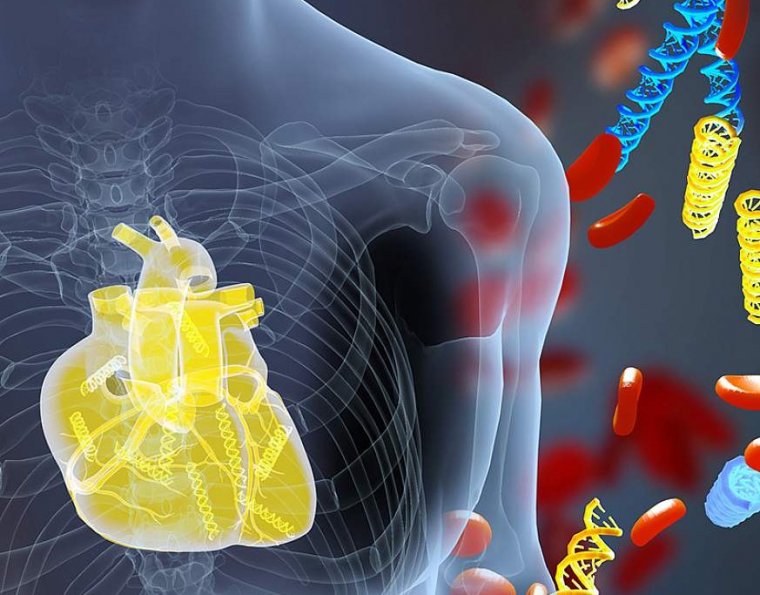| News / Science News |
Blood test shows promise for early detection of acute heart transplant rejection
Researchers have developed a blood test that could make it possible for doctors to detect — then quickly prevent or slow down — acute heart transplant rejection, a potentially deadly condition that occurs in the early months after a patient has received a donor heart. They estimate that the test could eliminate up to 80% of invasive heart tissue biopsies currently used to detect rejection.

Illustration shows DNA fragments (yellow) derived from a transplanted heart alongside the patient’s own DNA (blue). Photo: Erina He/NIH Medical Arts
In studies of a group of nearly 200 heart transplant recipients, the new blood test performed better than tissue biopsies, as it signaled problems even when no outward signs of rejection were evident.
“We showed in our initial assessment that this ‘liquid biopsy’ is highly sensitive for detecting acute rejection, finding it weeks to months before current clinical tools. This could potentially save lives in the wake of a critical shortage of donor organs,” said Hannah Valantine, M.D., senior study author and the former lead investigator of the Laboratory of Organ Transplant Genomics in the Cardiovascular Branch at the NHLBI.
Valantine said the test is also important for addressing serious health disparities. Because African Americans tend to have higher rates of heart transplant rejection and experience poorer transplant outcomes than other groups nationwide, the test could help reduce existing transplant-related health disparities that have persisted for decades.
The test, called the donor-derived cell-free DNA test, tracks DNA markers from the organ donor that appear in the blood of the transplant recipient.
Because injured or dying cells from the donor organ release lots of donor DNA fragments into the bloodstream compared to normal cells, higher amounts of donor DNA indicate a higher risk for transplant rejection in the recipient. The biomarkers can be detected using specialized lab equipment.
Current tests used to detect heart transplant rejection rely on frequent and painful biopsies of heart tissue. Those biopsies run the risk of damaging the heart and are limited by their invasiveness (ability to obtain tissue samples) and reliability for detecting acute rejection.
Acute, or rapid, rejection tends to happen in the first three to six months after transplantation as opposed to chronic rejection, which occurs after many years.
In the current study, the research team collected blood samples from 171 people who had recently undergone heart transplantation. The sampling included nearly 2,000 cell-free DNA measurements.
The population included a high percentage (about 44%) of African Americans. The researchers monitored the patients for signs of acute rejection for nearly 18 months using both traditional endomyocardial (heart tissue) biopsy and the new blood test.
The researchers found that the blood test performed better in their study than tissue biopsy, detecting higher amounts of rejection markers and earlier signs of rejection.
It also detected more instances of other types of transplant injury that were missed by biopsy, including so-called antibody mediated rejection, one of the deadliest forms of rejection and the hardest to treat and diagnose.
The new blood test may be able to detect rejection as early as 28 days after heart transplantation and at least three months before rejection is detectable using heart tissue biopsy.
Also, while current heart biopsies are only performed in hospitals, specimens for the new blood test can be collected at almost any commercial blood-collecting center. Since the blood test may lead to fewer biopsies, it could also provide significant financial savings.
In addition, the noninvasive blood test may provide a potentially safer alternative to invasive biopsies during viral outbreaks like the current COVID-19 pandemic.
However, the new test still has limitations. “This test will not completely eliminate the need for invasive procedures, but it can eliminate about 80% of the biopsies currently performed after heart transplant,” said study co-author Palak Shah, M.D., a heart disease specialist at Inova Heart and Vascular Institute, Falls Church, Virginia. (National Institutes of Health)
YOU MAY ALSO LIKE





